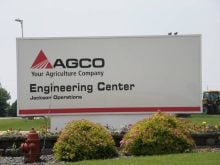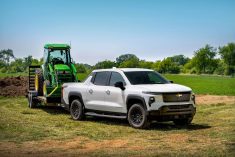ORLANDO, Fla. – Agco used the recent Ag Connect Expo farm equipment show in Orlando to introduce an electrically driven high clearance sprayer.
The machine, called the Electrogator, features electric instead of hydraulic wheel motors.
Hydraulically driven systems make it possible to move power without the need for solid drive linkages and allow manufacturers to deal with variable-rate drive issues and eliminate traditional clutches and geared transmission systems.
However, hydraulics also lose energy to heat, fluids, lines and pumps.
Three years ago, Agco began creating the first of what it hopes will be a variety of farm equipment that uses electricity.
Read Also

Canola support gets mixed response
A series of canola industry support measures announced by the federal government are being met with mixed reviews.
It started with a principle similar to that employed in trains, where a diesel engine drives a generator that feeds 650 volts of DC power to wheel motors.
Paul Haefner of Agco said the company chose a Rogator 1386 as the concept vehicle because of its wheel motors, four-wheel drive, four-wheel steering and the potential to improve its fuel efficiency.
“It turned out that moving to electric motors in place of the hydraulic ones was an easy concept with a challenging execution, but in the end it was 20 percent more efficient than hydraulics,” he said.
“You can burn 130 (US) gallons a day. Twenty percent of that is a lot of fuel. And this still is a concept machine. We aren’t nearly done with it.”
The machine uses many parts that were not specifically designed for it because it is still being used to test the idea of electric drives.
“We have a lot of refining to do with those, so this machine weighs about 2,000 pounds more than a hydraulic Rogator,” Haefner said.
“But that will drop as we develop things further.”
The motors have no magnets, rotor-bars or slip rings.
Six cables and a pair of control wires feed and direct the units. They produce 516 foot pounds of torque each and monitor their own speed, temperature and position.
“That is 36 percent more torque than a traditional motor,” he said.
“It means there is 35 percent more pulling power. When you’re running this thing, it just doesn’t pull down on hills. There is about six percent more horsepower being delivered than with hydraulics.”
That means the Caterpillar C9 engine’s 311 h.p. is better used and consequently burns less fuel to do the same job.
The Cat feeds a remotely mounted generator. It flows power controlled by a central computer processor that also sends signals to the wheel motors.
As a result, the wheels are driven only as fast as necessary to move the machine.
“In hydraulic systems you can manage flow to a point, but when an individual wheel motor begins to spin a tire in soft conditions or mud, more oil flows to that motor, compounding the problem,” he said.
Not so with the electrically governed wheels, which maintain their correct speed. While turning, they slow or increase speed from side to side to avoid slippage and field rutting.
“We don’t see turning ruts in the headlands,” Haefner said.
Braking is also mainly electric. The unit has the large discs that are standard on the 1386, but they are seldom used.
However, all of those processes create heat. Giant resistors bleed off heat when motors bake, which are also fluid cooled along with the generator.
“For now we don’t have a way of storing that energy to use later on, but that is a next step for the machine, and we have some ways to do that, that may not involve traditional battery systems,” Haefner said.
Agco also plans to improve energy savings by electrically powering the engine fan drive, the air conditioning compressor, the hydraulic pump, the product pump and the auxiliary power supply.
“We see the potential for combines, tractors and all sorts of other applications,” he said.
In other Agco spraying news, the Willmar SpraCoupe joined its larger RoGator siblings this month in their yellow paint scheme.














